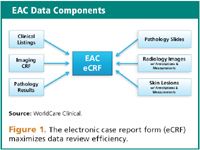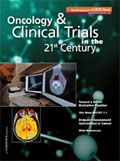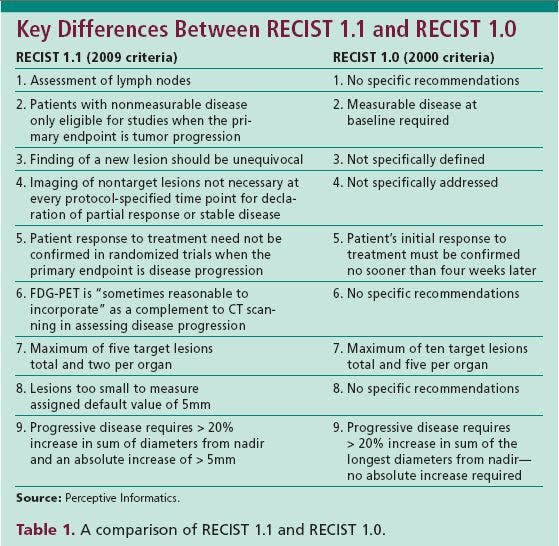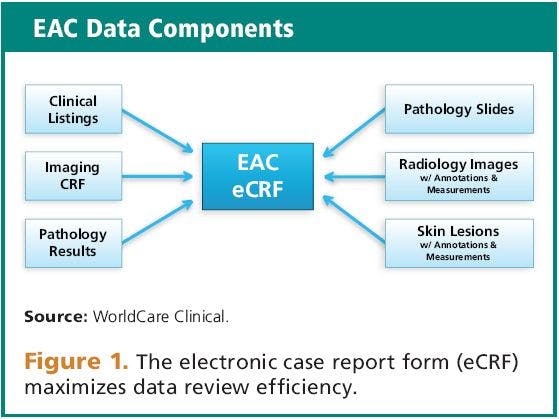A Team Approach
Applied Clinical Trials Supplements
How independent endpoint assessment committees can overcome imaging limitations.
Hstorically, the endpoint gold standard for demonstrating clinical benefit in oncology drug trials has been and still is overall survival (OS). From the FDA perspective, OS provides the most objective and comprehensive means of evaluation, but the analysis is not without its drawbacks.
Because evaluation of OS requires large patient numbers and much longer follow-up compared with other endpoints, data receipt is delayed. Trials based primarily on survival are therefore always more expensive and time consuming, and FDA approval takes longer than when based on studies using other accepted primary efficacy endpoints, such as time to progression (TTP) or objective response rate (ORR). Plus, overall survival may be confounded by subsequent therapies, unlike endpoints such as TTP or ORR, which are often used as surrogates for OS in patients with solid tumors.
These tumor assessment endpoints are less expensive and much more time effective than OS, and are, therefore, an attractive alternative for demonstrating efficacy. Because they are based on subjective evaluations (i.e., clinical or radiological observations), however, they are also less objective than overall survival and must be used in accordance with strict quality control measures to ensure validity.
Specifically, certain design features can be incorporated into a clinical trial to minimize bias and increase precision and accuracy of potentially subjective observer-dependent assessments. To increase uniformity of efficacy endpoints based on tumor assessments, sponsors and CROs must pay special attention to the blinding of patient data. Accordingly, the use of central (external) review committees is recommended, because without independent central review, bias stemming from the sponsor or study monitor's familiarity with particular patients may influence endpoint assessments. Moreover, the FDA can and will question the validity of the conclusions drawn if stringent processes are not put in place to reduce the potential for bias.
Reducing bias
Efforts to encourage uniform interpretation of endpoint data among assessors and to minimize assessment variability across the study should be part of the study design prior to patient enrollment. A good example of a design intended to reduce variability of endpoint assessments is a double-blind read with adjudication. By this process, radiological images are initially assessed by multiple, often two, independent blinded reviewers. If the reviewers disagree, then a third adjudicating assessment (i.e., a tie-breaker) is made by an additional reviewer who may or may not be blinded to prior assessments. To further minimize variability, all independent reviewers should be uniformly trained and periodically tested to evaluate intra- and inter-reader variability.
Implementation of double-blind read with adjudication in Phase III oncology trials became more widespread in the late '90s based, in large part, on the need for accurate, unbiased radiological assessment in patients with solid tumors. This need arose partly because of the addition of Subpart H to new drug approval regulations promulgated in 1992, which allowed for accelerated drug approval using surrogate endpoints involving radiological assessment of tumor sizing. By the end of the millennium, however, it had become apparent that although endpoints such as ORR can support regulatory approval in select solid tumors, relief of tumor-related symptoms and drug toxicity should also be considered when making approval decisions.
Moving into the 21st century, solid tumor trials started using independent endpoint assessment committees (EACs) that used the data from the independent imaging assessment committee in conjunction with information from sites. Although these endpoint assessment and adjudication committees use a combination of independent blinded imaging data and site data, their goals and processes are the same as the independent imaging assessment committee, and their determination of response is often positioned as the primary efficacy result of a Phase III trial.
This is particularly important because tumor response alone is not always sufficient data for regulatory review. The FDA and other regulatory agencies are looking increasingly to a more objective and encompassing view of the drug's effect, and the use of the EAC offers an evaluation of this efficacy. Data for regulatory submission is not only comprised of bias-free tumor assessment with standardized quantification (e.g., WHO or RECIST criteria), but must also include clinical and pathology data to confirm the radiological analysis.
Not only do EACs reduce physician bias (blinded reviews coupled with off-site specialists serve to eliminate the potential for prior knowledge of the status of the patient) but they also help to overcome the limitations inherent in imaging that may make precise diagnosis difficult. Especially valuable for subjective endpoints, they provide a far more complete method for determining total tumor and drug effect when a complicated definition of efficacy is required.
Still relatively novel, EACs are most prevalent in oncology trials, although the FDA's push toward more robust and definitive datasets for regulatory approval means that they will become important to all therapeutic areas in the future.
Current FDA efforts to draft guidance documents for EACs closely resemble those for cancer endpoints in clinical trials, including survival, tumor response, response duration, relief of symptoms, or composite clinical benefit endpoints. The FDA has intended to develop the series of guidances on oncology endpoints through a process that includes public workshops and discussions before its Oncologic Drugs Advisory Committee, and each subsequent guidance is to focus on endpoints for specific cancer types to support drug approval or labeling claims.
Building the EAC
For oncology trials, the EAC is defined by the oncologist(s), who utilizes data beyond radiology images, including clinical data, pathology results, and other physical measurements (e.g., skin lesions for cutaneous lymphoma, etc.) to more holistically determine the disease status of the patient. Specifically, board-certified oncologists are required, but it is also often of value to have radiology and pathology representation on the committee. All members must be trained under an EAC chair to minimize variability among assessments and to determine the different roles each clinical specialist plays in them.
The EAC chair should be a member of the committee and will be the point of authority for determining information needed for assessment (i.e., adverse events, histology, calibrated photos, magnetic resonance imaging, etc.). They should work with the imaging CRO, sponsor, FDA, and radiologist to design the EAC charter, which is essential to ensuring unbiased assessment of all clinical outcomes. Specifically, this responsibility includes development of a decision algorithm for response assessment and determination of work load and time estimates for all committee members. Once the charter and training and testing programs have been designed, full training commences and the program is put into operation.
Objectivity of the earlier mentioned guidances and workshops is especially critical in fields in which endpoints are determined by clinical or radiological examinations, rather than by predefined laboratory measurements. This is where an independent EAC can be invaluable. Through a charter, EACs can facilitate an unbiased assessment of clinical outcomes in a multicenter Phase III oncology trial to enable a uniform, controlled-assessment process that is independent of the sponsor. Most importantly, the endpoint assessment and adjudication committee charter enables objectivity of endpoint assessment and approximates the critical review that the FDA might impose on clinical endpoint data. The endpoint assessment and adjudication committee charter should be reviewed rigorously in consultation with the FDA, resulting in a charter that may prove to be a useful example in generating independent assessment of pivotal clinical outcomes.1-7
EACs and QA
For Phase III registration trials, regulatory agencies must be able to reach objective and definitive conclusions from data. Independence and consistency in the interpretation of the clinical endpoints across different geographic areas and over the course of the study is a primary challenge that can be met by using a central assessment and adjudication committee. The successes of central review committees and, by extension, the success of the trials, depend on prospectively defined procedures, which are agreed upon by the FDA. In addition, the FDA prefers that radiological assessments be done by a central review.
This role is almost exclusively performed by an imaging core laboratory. Imaging core laboratories or central imaging laboratories have historically been focused on managing the collection of consistent, high-quality imaging data and ensuring minimal variability through a central reading committee. Integration of clinical data with radiological data is often required to make an assessment, and thus quality control procedures, similar to those for imaging data, should be implemented.
Additional important considerations, such as defining a procedure for adjudication between a site physician's assessment and assessments made by a central review committee, may also need to be addressed. These adjudications can be very complicated and must be prospectively defined and agreed upon by the FDA in order for them to have any regulatory value.
If implemented properly, the use of an imaging CRO or an imaging core lab helps minimize the possibility of sponsor bias in the assessment process. A sound data management and statistical analysis plan developed by both parties at the outset of the trial should be in effect throughout and should be designed to prohibit sponsor access to the data until the final outcome is determined. Only when the assessment portion of the trial has closed is it appropriate for the EAC to share conclusions with the sponsor. This way, physicians who help deliver the subject's day-to-day care do not perform assessment of outcomes, and the application of uniform response criteria across all assessment individuals is feasible.
The technological approach that a CRO takes can have a critical impact on the successful implementation of an EAC and subsequent speed of potential therapeutic approval. The right approach can help facilitate the coordination of data collection and the integrated assessment process to optimize workflow and ensure data validity. A fully digitized process that removes bias in document data handling is especially important for regulatory submission, and a CRO with an automated data management system in place can streamline all data capture and transmission, while displaying and launching all the relevant data from the electronic case report form (see Figure 1). This usually includes clinical site data, independent radiological assessments, and pathology reports with histology images. For melanoma trials, skin lesion images with annotations and measurement will also be required.

Figure 1
Portals that are part of a larger, Web-based, auditable technology can provide a central point for all trial activity and allow project managers, EAC members, and on-site clinicians to coordinate the assessment procedure. Particularly important are automated procedures for quality control, such as the ability to determine the need for adjudication on a specific case and to forward the image to an appropriate adjudication reviewer. This way, the adjudication reviewer can be distinct from the primary reviewer and can possess specified qualifications (e.g., certain level of training and/or experience).
These kinds of specialized capabilities will become increasingly important as clinical data and the accompanying reports go digital. Additionally, the ability to provide a digital audit trail coupled with an interactive database that combines clinical information with images, EAC and adjudication results will be a necessity for FDA submission and approval moving ahead.
Conclusion
Endpoint assessment and adjudication committees are helping to reformat the landscape of oncology drug development. Understanding how EACs fit into the trial process and their potential for improving the chances for regulatory success will become a priority for all oncology sponsors in the coming years, and so the quality control measures and technology requirements necessary for their effective implementation demand our paramount attention.
Richard Walovitch , PhD, is Chief Medical Officer and John Tomera , PhD, is Director of Regulatory Affairs and Associate Medical Director at WorldCare Clinical, 7 Bulfinch Place, P.O. Box 8908, Boston, MA 02114.
References
1. Guidance for Industry: Clinical Trial Endpoints for the Approval of Cancer Drugs and Biologics, May 2007, U.S. DHHS, CDER, CBER, http://www.fda.gov/downloads/Drugs/GuidanceComplianceRegulatoryInformation/Guidances/ucm071590.pdf.
2. International Conference On Harmonisation Of Technical Requirements For Registration Of Pharmaceuticals For Human Use, ICH Harmonised Tripartite Guideline, Statistical Principles For Clinical Trials E 9, Current Step 4 version, dated 5 February 1998, http://www.ich.org/LOB/media/MEDIA485.pdf.
4. R. Pazdur, "Endpoints for Assessing Drug Activity in Clinical Trials," The Oncologist, 13 (suppl 2), 19-21 (2008).
5. R.C. Kane et al.,"Sorafenib for the Treatment of Unresectable Hepatocellular Carcinoma," The Oncologist, 14, 95-100 (2009).
6. Guidance for Industry: Patient-Reported Outcome Measures, Use in Medical Product Development to Support Labeling Claims, December 2009, U.S. DHHS, CDER, CBER, and CDRH, http://www.fda.gov/downloads/Drugs/GuidanceComplianceRegulatoryInformation/Guidances/UCM193282.pdf.
7. Guidance for Industry: Evidence-Based Review System for the Scientific Evaluation of Health Claims—Final. January 2009. U.S. DHHS, FDA, Center for Food Safety and Applied Nutrition, http://www.fda.gov/Food/GuidanceComplianceRegulatoryInformation/GuidanceDocuments/FoodLabelingNutrition/ucm073332.htm.










